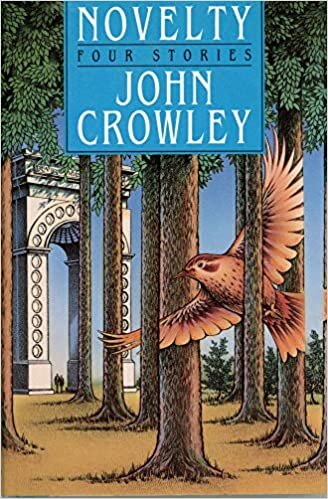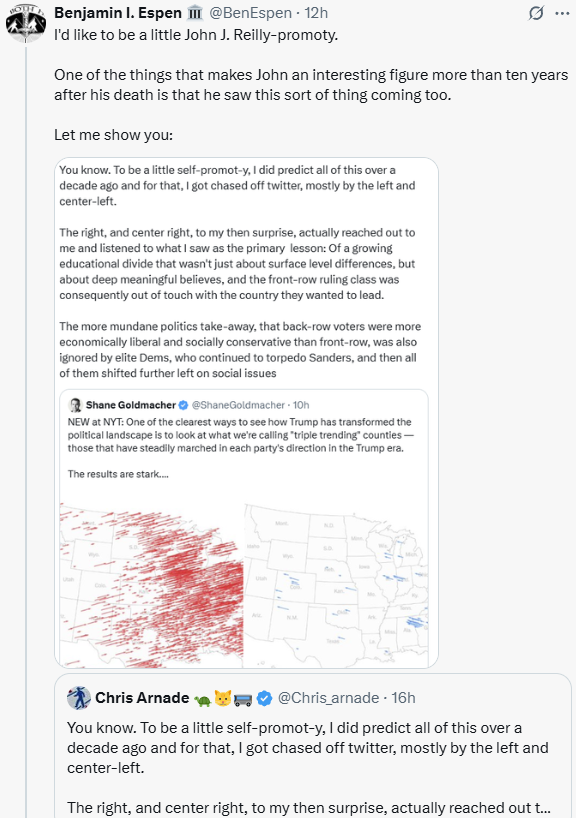The Long View: Novelty
John J. Reilly had quite an interest in the works of John Crowley. I’ve never read anything by him, but this review of four short stories titled Novelty [Amazon link] almost tempts me. Crowley reminds me a lot of Tim Powers, but with greater literary pretensions, which is why I’m almost tempted. I really do like adventure fiction, not what passes for literature.

Novelty
By John Crowley
Doubleday, 1989
227 Pages, US$6.95
ISBN 0-385-26171-3 HB
People call John Crowley a "writer's writer." That's not necessarily much of a compliment. At best, "writer's writer" means someone whose themes and style are influential, but whose books do not enjoy particularly large sales. At worst, it means a fiction writer who spins fascinating premises, but who cannot tell a story to save his life. Crowley can in fact do both, and at the same time: his novella, "The Deep," set in a flat world that resembles Elizabethan England, is proof enough of that. Still, people who read Crowley are perhaps more interested in his disconcerting ideas about the fluidity of history and the ubiquity of angels than in the narratives through which he expounds on these good things.
The four stories in this collection lean toward the conceptual side. They are just long enough to get the ideas across, but too short to drag. Readers may find them helpful in understanding the premises of Crowley's great work, the Aegypt series, the fourth volume of which should be published sometime between now and doomsday. (He took a break to write his latest novel, an unrelated work called "The Translator.")
The story with the most resonance in this collection is the novella, "Great Work of Time." I wonder why the story is not better known among the world's conspiracy theorists, since it depicts the operations of the greatest of all conspiracies, the one that Cecil Rhodes (1853-1902) allegedly organized on behalf of the Anglo-American Establishment.
There is some real history here. Rhodes did see to it that part of the fortune he made during the Scramble for Africa in the last quarter of the 19th century went to fund institutions promoting the unity of the English-speaking world. The most famous result was the Rhodes Scholarships. Almost as well known are the Round Table Groups in the Commonwealth countries and the Council on Foreign Relations in the United States. Those private associations did indeed exercise a significant effect on 20th century statecraft; anyone interested should take a look at Carroll Quigley's Tragedy & Hope. However, rumor and mythmaking have exaggerated the power of those private associations into a secret world government, a conspiracy of archons.
In "Great Work of Time," we see a young bureaucrat in the British Colonial Service being recruited into the conspiracy in 1956, while traveling for home leave on the Cape to Cairo railway. I actually had to check to make sure that Rhodes's dream of such a railway was never realized. Another early hint that all is not what it seems in this story is the final leg of the bureaucrat's journey on a British zeppelin. In any case, when he reaches London, he meets the Otherhood, the obscure but powerful group that has been using time travel to manipulate history for the preservation and expansion of the British Empire.
They have met with some success, but their success is never permanent. They cannot fix the unpleasantness of 1914 just once, for instance. They must do it again and again, as new problems arise with every change they implement. Fortunately, they have a headquarters that is outside of time. It's rather like the headquarters in Isaac Asimov's "The End of Eternity" (1955), except that the Otherhood's headquarters is the kind of gentleman's club where you might expect to find Mycroft Holmes. The Otherhood's self-image as a force for stability turns out to be chimerical, however.
The problem is that the members of the Otherhood never really return from the pasts they have altered. Instead, they return to a future that is not quite the future of the new history they have just created. Crowley's efforts to explain the "orthogonal logic" of time travel do not bear close examination, but the important point is that each new present remembers a new past, which is never quite the past the Otherhood intends. The disparities are manageable for the few decades in which the Otherhood permits itself to operate. Eventually, however, the President Pro Tem of the Otherhood steps into the early 21st century, where he finds a world that has always had multiple intelligent species, some of them unhuman and others unnatural. One of the latter explains where the temporal churning of the early 20th century is driving the world:
"I shall tell you what I see at the end of all your wishings," said the angel softly. "At the far end of the last changed world, after there is nothing left that can change. There is then only a forest, growing in the sea. I say 'forest' and I say 'sea,' though whether they are of the kind I know, or some other sort of thing, I cannot say. The sea is still and the forest is thick; it grows upward from the black bottom, and its topmost branches reach into the sunlight, which penetrates a little into the warm upper waters. That's all. There is nothing else anywhere forever. Your wishes have come true: the Empire is quiet. There is not, nor will there be, change anymore; never will one thing be confused again with another, higher for lower, better for lesser, master for servant. Perpetual Peace."
This state of affairs is never quite instantiated; the story is wrapped up with the kind of conclusion familiar to us from tales ranging from William Jacobs's "The Monkey's Paw" to Ursula LeGuin's "The Lathe of Heaven." However, there is nothing wrong with a story that leaves us almost where we started. It's the stories that go round and around that are annoying.
Another story in this collection, "In Blue," is at least as original. It takes place in a post-historical anarchist society. It's the future of Earth, but it is reminiscent in some ways of the Commensality of Anarres in Ursula LeGuin's "The Dispossessed," and in others of Ayn Rand's "Anthem." This society lives among ruins whose significance interests it not at all. It has a social structure as flat as a pancake, though there is a corps of blue-clad cadres whose business it is to devise applications of revolutionary theory. That is the really interesting part, a computer-based ideology called "act-field theory."
In the world without a past, there are still sometimes riots and famines and migrations. Act-field theory does not predict these things, but it does "account for" them. It demonstrates that they are nothing out of the ordinary, so no special explanations are needed. Act-field theory shows that the world is not going anywhere, that history has no structure, and so that hierarchies are unnecessary to preserve the past or create a future. Society consists of a transient mob. It's rather like the post-proletarian "multitude" of Hardt & Negri's anarchist tract, Empire, though Crowley's make-believe sociology makes rather more sense than Hardt & Negri's postmodernism.
In any case, just as the world of "In Blue" lacks a history, so it is short on plot. A cadre has a nervous breakdown and then recovers in such a way that his understanding of act-field theory is deepened.
And speaking of postmodernism, how are we to know when, if ever, a character in a story should be taken as speaking for an author? That is the puzzle set by a the title story, "Novelty." It describes the meditations of an author sitting in a bar during the day, suffering from a mild case of writer's block. The author has a taste for alternative history with a Gnostic and anti-Catholic bent. For instance, he considers setting a story in a world in which Jesus refused the Crucifixion, the better to conform Himself to human weakness. There would be a Catholic Church of sorts, but its pope would live in a rundown Victorian mansion in Albany, New York.
These exercises in high concept are not the same thing as a story, the author realizes. He is desperate for a theme for a novel. This is what he has to say for himself in his frustration:
"[H]e had really only the one subject, if subject was the word for it, the idea of a notion or a holy thing growing clear in the stream of time, being made manifest in unexpected ways to an assortment of people: the revelation itself wasn't important, it could be anything, almost. Beyond that he had only one interest, the seasons, which he could describe endlessly and with all the passion of a country-bred boy grown old in the city."
Again, nothing much happens. The writer comes close to propositioning a woman he later learns is the bartender's wife. He also comes up with a slim idea for a novel, in which the play of the antitheses of the wonder of novelty and the longing for security will be used to explicate his personal take on revelation.
Only the first story in the collection, "The Nightingale Sings at Night," is really plot-driven. The plot is not original. The story recasts "Genesis" slightly; god is a somewhat clueless female, and death turns out to be not just man's fault, but also his invention. If John Crowley wrote more stories like this, he would no doubt be better known: this is the kind of thing that used to get anthologized by the "The Twilight Zone." On the whole, though, his readers would prefer he continue to do just what he has been doing.
Copyright © 2008 by John J. Reilly



Comments ()